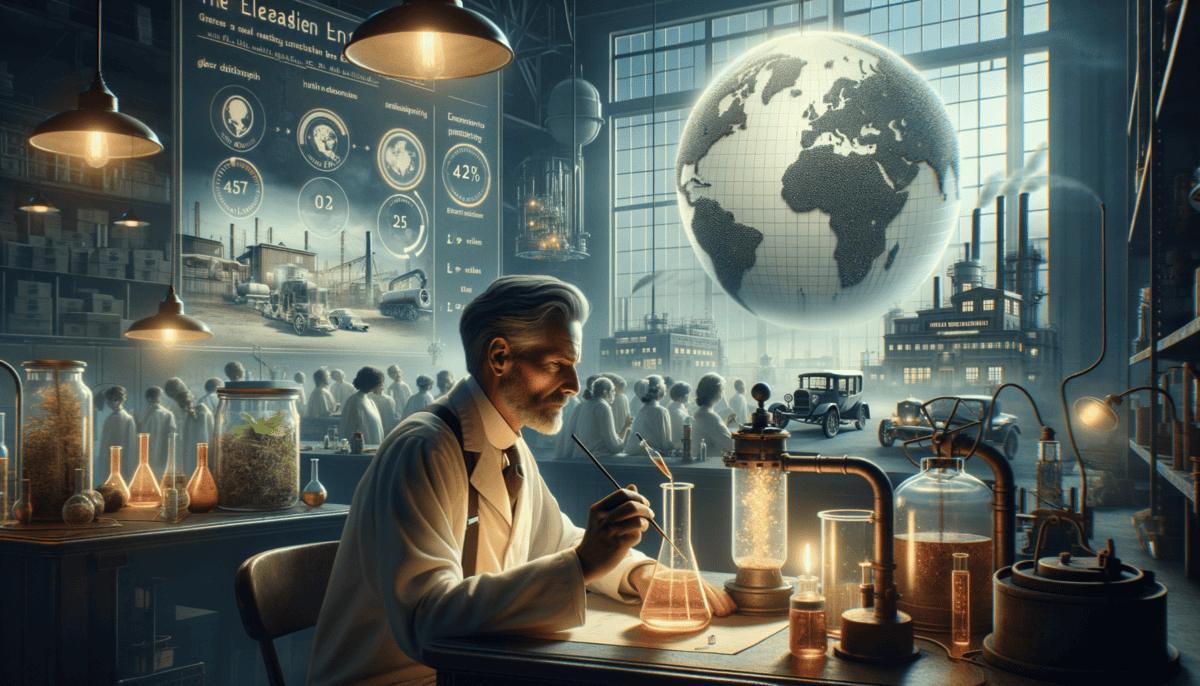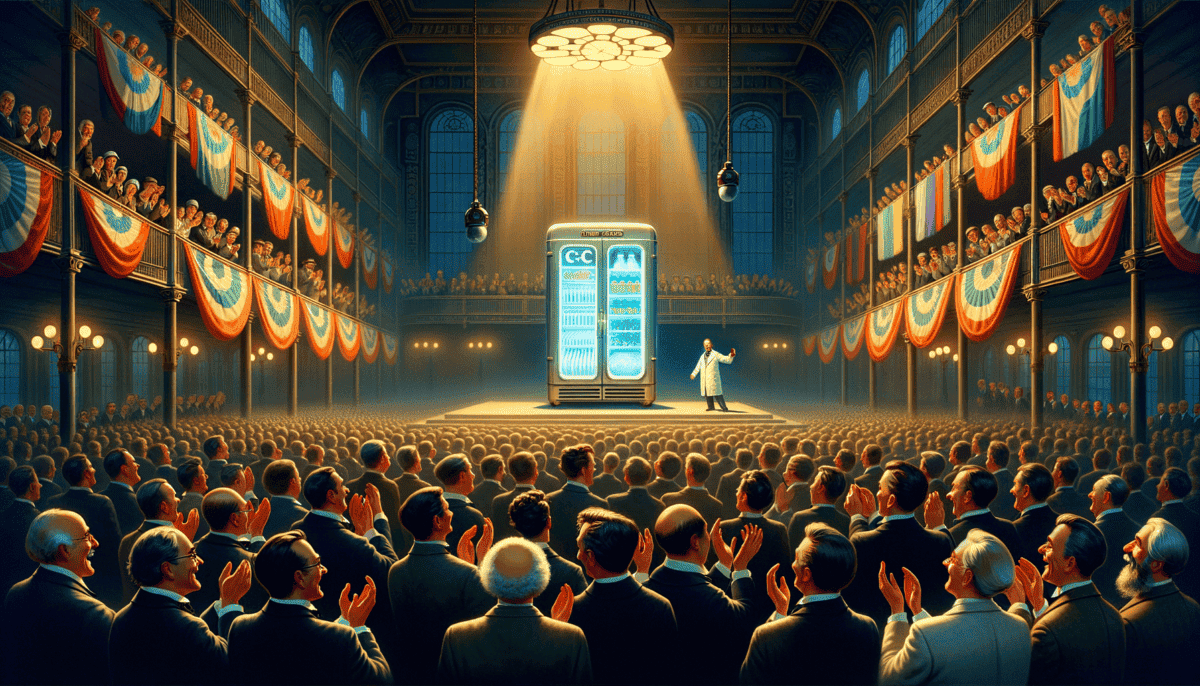A Boy Who Loved to Build
Young Tommy Midgley sat at his father's workbench, his eyes wide with wonder. It was 1895, and he was just six years old. The smell of wood shavings and metal filled the air as his father worked on a new invention.
"What are you making, Papa?" Tommy asked, standing on his tiptoes to see better.
"A new kind of wheel, son," his father replied with a smile. "Sometimes the best ideas come from trying to solve problems."
Tommy loved watching his father work. His dad wasn't just any inventor – he was the head of a company that made car tires!
Growing Up Different
While other kids played with toys, Tommy built things. He took apart his mother's kitchen clock just to see how it worked. Sometimes his experiments didn't go well – like when he accidentally broke the family radio trying to make it play louder!
"That boy," his mother would say, shaking her head with a smile, "always trying to figure out how things work!"
“I don’t just want to know how things work,” Tommy would say. “I want to make them work better!”
School Days and Science Ways
In school, Tommy was different from other kids. While they struggled with math, he solved problems quickly. His teachers noticed something special about him.
"Tommy," his science teacher said one day, "you have a gift for understanding machines. Use it wisely."
Big Dreams, Bigger Ideas
As Tommy grew older, he dreamed bigger and bigger. He wanted to solve the world's problems through science. At night, he would sketch ideas in his notebook:
• A better engine for cars
• A quieter typewriter
• A machine to help sick people
The First Big Challenge
When Tommy was in college, he faced his first real challenge. He had to build a machine that could lift heavy things. Most students made simple machines, but not Tommy. He built one that could lift twice as much!
His professor was amazed. "Midgley," he said, "you're going to change the world someday."
A New Century of Possibilities
It was an exciting time to be an inventor. Cars were new. Electricity was spreading across America. People believed science could fix anything!
Tommy wrote in his diary: "There are so many problems to solve. I want to make things better for everyone."
Little did he know that his biggest inventions were still ahead – and that they would change the world in ways nobody expected.
His mother found him one evening, still working late on a new project.
"Tommy," she said gently, "it's time for bed."
"Just five more minutes," he replied, not looking up from his work. "I think I'm close to something amazing."
And he was right – but not in the way anyone could have guessed. The curious little boy who loved to build things would grow up to create inventions that would affect every person on Earth.
The Gas That Changed Everything
The year was 1921, and Thomas Midgley Jr. had a big problem to solve. Cars were making strange noises – KNOCK! KNOCK! KNOCK!
The Knocking Problem
“What’s that terrible sound?” asked Charles Kettering, Thomas’s boss at General Motors.
“That’s engine knock,” Thomas explained. “It happens when the fuel burns wrong. It’s like having hiccups in your car!”
Testing, Testing, Testing
Thomas tried everything to fix the problem. He tested hundreds of different things to add to gasoline:
• Sugar
• Food coloring
• Even perfume!
Nothing worked. But Thomas didn’t give up.
The Big Discovery
One day, Thomas tried something new – a chemical called tetraethyl lead. When he put it in the gas tank…
“The knocking stopped completely!” Thomas shouted with joy. “It works perfectly!”
His boss was so happy, he gave Thomas a big bonus. General Motors started making this new gas right away. They called it “Ethyl gasoline.” ⛽
A Dark Cloud Forms
But soon, strange things started happening at the factory where they made the new gas. Workers got sick. Some had to go to the hospital.
“Don’t worry,” Thomas told everyone. “The lead is perfectly safe!”
To prove it, he did something very dangerous. He washed his hands in the leaded gas and breathed in the fumes for a whole minute!
Success and Worry
Cars everywhere started using the new gas. They ran better than ever before! But doctors started noticing something wrong. More and more people were getting sick.
“Could it be the new gas?” some scientists asked.
“No way!” said the car companies. “Look how well the cars run now!”
A Heavy Price
Thomas was proud of his invention. It made cars work better. It made his company lots of money. But he didn’t know that his “solution” would cause big problems.
The lead from all those cars was going into the air. It was getting into the soil. It was making people sick without anyone knowing why.
Moving Forward
Thomas kept working on new ideas. He believed science could solve any problem. But the story of leaded gas wasn’t over – it was just beginning.
One evening, as Thomas watched cars zoom by on the street, a friend asked him, “Do you ever worry about what your invention might do?”
Thomas smiled and said, “Progress always comes with a price. We just have to make sure it’s worth it.”
But was it worth it? That was a question that would take many years to answer.
Dark Clouds of Lead
As more cars started using leaded gas, something scary was happening. The air was getting dirty, and people were getting sick. But nobody knew why!
The Mystery Illness
“Doctor, why do I feel so tired all the time?” asked a little boy.
The doctor scratched his head. More and more people were coming to his office feeling sick. They all lived near busy roads where lots of cars drove by.
• Headaches
• Feeling very tired
• Trouble thinking
• Tummy aches
Thomas Gets Worried
Thomas Midgley started hearing bad news. Workers at his factory were getting very sick. Some couldn’t walk straight. Others couldn’t remember things.
“Maybe we should check if the lead is making people sick,” said one of Thomas’s friends.
But Thomas didn’t want to believe his invention could hurt people. He had worked so hard to make cars better!
The Truth Comes Out
Scientists started doing tests. They found lead everywhere:
In the air near roads ️
In the dirt where children played
In the blood of people who lived in cities
Thomas Feels Bad
When Thomas learned how dangerous lead was, he felt terrible. He had wanted to help people, not hurt them!
“I was trying to make cars better,” he said sadly. “I didn’t know the lead would be so dangerous.”
The World Wakes Up
Doctors and scientists started telling everyone about the danger of lead. They said:
“We must stop using leaded gas! It’s making our air dirty and our children sick!”
But the car companies didn’t want to change. They were making lots of money from leaded gas.
Fighting for Change
Some brave people started fighting to stop the use of leaded gas. They wrote letters to newspapers. They talked to government leaders. They wanted clean air for everyone!
A Hard Lesson
Thomas learned something very important: When you invent something new, you must think about how it might hurt people or the Earth.
“I wish I had known better,” Thomas said. “We must be more careful with our inventions.”
But Thomas wasn’t done inventing yet. He had another big idea coming – one that would change the world in a whole new way…
Cool Dreams, Hot Problems
After the scary problems with leaded gas, Thomas Midgley wanted to make something safer. People needed help staying cool in hot weather. ️
A Hot Problem
“It’s so hot in here!” people would say on summer days. The old ways of cooling homes and food weren’t working well.
• Catch fire easily
• Make people very sick
• Leak bad smoke
Thomas Gets an Idea
“I can make something better!” Thomas said. He worked day and night in his laboratory.
One day, he jumped up from his desk. “I’ve got it!” he shouted. He had invented something new called CFCs.
The Magic Chemical
Thomas showed his new invention to everyone. He did a special trick:
“Watch this!” Thomas said. He breathed in some CFC gas and blew out a candle. “See? It’s completely safe!”
People were amazed! The new chemical:
❄️ Made things cold very fast
Didn’t smell bad
Wouldn’t catch fire
Seemed safe to breathe
Everyone Wants CFCs
Soon, CFCs were everywhere:
• In refrigerators to keep food cold
• In air conditioners to cool homes
• In spray cans for hairspray and paint
• In factories to make things clean
A Cool Success
“This is my best invention yet!” Thomas said proudly. People all over the world agreed.
Factories started making millions of pounds of CFCs. Every home wanted a refrigerator. Every office wanted air conditioning.
But Wait…
Nobody knew it yet, but these CFCs were floating up into the sky. Way up high, they were starting to cause a big problem.
“The chemicals just disappear into the air,” people thought. “They can’t hurt anything up there!”
More Success, More Trouble
Thomas was happy. His new invention was helping people stay cool. It wasn’t making anyone sick like the lead had.
But high up in the sky, something strange was happening. The CFCs were starting to break down the Earth’s special blanket that protects us from the sun.
It would be many years before anyone discovered what these friendly-seeming chemicals were really doing to our world…
Danger in the Sky
High above Earth, something scary was happening. Scientists started noticing a big hole forming in our sky’s protective blanket.
A Strange Discovery
One sunny morning in 1985, a group of scientists looked at their measurements and gasped.
“Look at these numbers!” said Dr. Joe Farman. “The ozone layer is disappearing!”
The ozone layer is like Earth’s sunscreen. It protects us from the sun’s harmful rays. And it was getting thinner because of Thomas Midgley’s CFCs.
Following the Clues
• CFCs float up very high in the sky
• They break apart the ozone layer
• This lets dangerous sunlight reach Earth
• The damage spreads like a growing hole
A Growing Worry
People everywhere started to worry. Without the ozone layer, life on Earth would be in big trouble!
“We have to do something!” scientists told world leaders. “The hole is getting bigger every year!”
Nature Sends Warning Signs
Strange things began happening:
Animals in Antarctica got sunburned
Plants had trouble growing
More people got skin problems
️ Earth started getting warmer
The World Takes Action
In 1987, countries around the world made an important promise. They would stop using CFCs to protect the ozone layer.
People had to find new ways to:
• Keep food cold
• Cool their homes
• Make spray cans work
• Clean things in factories
Hope for Healing
“The ozone layer can heal,” scientists said. “But it will take a long time.”
Slowly, the hole in the ozone layer started getting smaller. But the damage from Thomas’s invention would last for many years.
A Difficult Truth
“Sometimes the things we create to help people can end up causing problems we never expected,” a wise scientist explained.
Thomas Midgley never knew about the ozone hole. He thought he was making the world better with his cool invention.
The story of CFCs taught everyone an important lesson: we must protect our Earth while trying to make life better. The air we can’t see is just as important as the ground we walk on.
A Tangled Ending
Thomas Midgley’s life ended in a strange and sad way. He became his own last invention’s victim.
The Final Invention
In 1940, Thomas got very sick. Polio made it hard for him to move. But being an inventor, he had an idea!
“I’ll build a special machine to help me get out of bed,” Thomas told his family.
He created a system of ropes and pulleys, like a fancy elevator for his bed. ️
A Tragic Twist
One day in 1944, Thomas got tangled in the ropes of his machine. His clever invention became a dangerous trap.
This was a sad ending for someone who wanted to make the world better.
Looking Back at Thomas’s Life
Thomas tried to solve big problems:
Cars that didn’t run well
❄️ Keeping food cold
Making homes comfortable
• Made cars run smoother with leaded gas
• Created CFCs for refrigerators
• Helped many industries grow
The Price of Progress
“Thomas was clever,” said a historian. “But he didn’t know his inventions would hurt people and the Earth.”
His story teaches us important things:
Think carefully before making new things
Remember to protect our Earth
Good ideas can sometimes have bad results
A Better Future
“We learn from mistakes of the past to make tomorrow better,” a modern scientist explained.
Today, people work hard to:
Make clean energy
Protect nature
Test new inventions carefully
Remembering Thomas
Thomas Midgley wasn’t a bad person. He was someone who tried to help but didn’t see the big picture. His story reminds us to be careful when we change our world.
Every new invention is like dropping a pebble in a pond – the ripples spread far and wide. We must watch those ripples carefully!
Today’s inventors learn from Thomas’s story. They work hard to make sure their new ideas help people AND protect our Earth. Together, we can create a better, cleaner, safer world for everyone!
“The future belongs to those who learn from the past and dream of better ways forward.”
And so, the story of Thomas Midgley Jr. lives on, teaching new generations about the power and responsibility of human creativity.






